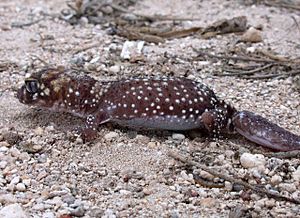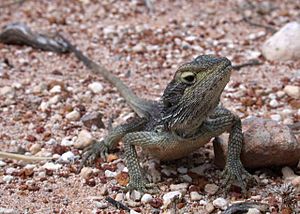List of reptiles of the Houtman Abrolhos facts for kids
The Houtman Abrolhos is a group of 122 islands and coral reefs. It is located off the coast of Western Australia. These islands are a special home for many animals. One amazing group of animals found here are reptiles!
Scientists have found 24 different kinds of land reptiles on the Houtman Abrolhos. You can also often see the large marine green turtle (Chelonia mydas) swimming near the shores. This article will tell you more about the cool reptiles living in this unique island chain.

Contents
What are Reptiles?
Reptiles are a group of cold-blooded animals. This means their body temperature changes with their surroundings. They are covered in scales or scutes. Most reptiles lay eggs, but some give birth to live young. Common reptiles include snakes, lizards, turtles, and crocodiles.
Reptiles have lived on Earth for millions of years. They are very good at adapting to different environments. The Houtman Abrolhos islands offer a perfect home for many reptile species.
Lizards of the Abrolhos
The Houtman Abrolhos islands are home to many types of lizards. Lizards are a very diverse group of reptiles. They come in many shapes and sizes.
Geckos: Nighttime Hunters
Geckos are small lizards known for their sticky toes. These toes help them climb walls and even ceilings! Many geckos are active at night. They hunt insects and other small creatures.
Some geckos you might find here include:
- Marbled gecko (Christinus marmoratus): This gecko has a beautiful marbled pattern on its skin.
- Clawless gecko (Crenadactylus ocellatus): As its name suggests, this gecko does not have claws.
- Ornate stone gecko (Diplodactylus ornatus): This gecko often blends in with rocks.
- Variegated dtella (Gehyra variegata): A common gecko with varied patterns.
- Binoe's prickly gecko (Heteronotia binoei): This gecko has small, prickly scales.
- South-western spiny-tailed gecko (Strophurus spinigerus): It has spines on its tail for defense.
- Barking gecko (Underwoodisaurus milii): This gecko makes a barking sound when it feels threatened.
Legless Lizards: Snakes or Lizards?
Some lizards have lost their legs over time. They look a lot like snakes! But they are still lizards. You can often tell them apart from snakes by their eyelids and ear openings. Snakes do not have these.
Types of legless lizards in the Abrolhos include:
- Marble-faced delma (Delma australis)
- Gray's legless lizard (Delma grayii)
- Burton's legless lizard (Lialis burtonis): This lizard has a very long snout. It is known for eating other lizards.
Skinks: Common and Diverse
Skinks are a very large family of lizards. They usually have smooth, shiny scales. They also have short legs and long bodies. Many skinks live on the ground or burrow in the sand.
Some skinks found here are:
- Spiny-palmed snake-eyed skink (Cryptoblepharus carnabyi)
- West Coast ctenotus (Ctenotus fallens)
- King's skink (Egernia kingii): This is a larger skink.
- Spiny-tailed skink (Egernia stokesii stokesii): This skink has a spiny tail for protection.
- South-western four-toed lerista (Lerista distinguenda)
- West Coast four-toed lerista (Lerista elegans)
- West Coast line-spotted lerista (Lerista lineopunctulata)
- Western worm lerista (Lerista praepedita)
- Common dwarf skink (Menetia greyii)
- Western pale-flecked morethia (Morethia lineoocellata)
- Southern pale-flecked morethia (Morethia obscura)
Bearded Dragons: Sun Lovers
The Abrolhos dwarf bearded dragon (Pogona minor minima) is a special lizard. It is a smaller version of the well-known bearded dragon. These lizards love to bask in the sun. They often puff out their "beard" when they feel threatened.
Snakes of the Abrolhos
Snakes are reptiles without legs. They move by slithering. The Abrolhos islands are home to a few snake species.
- Carpet python (Morelia spilota imbricata): This is a non-venomous snake. It is a constrictor, meaning it squeezes its prey.
- Coastal burrowing snake (Simoselaps littoralis): This snake spends much of its time underground.
Turtles of the Abrolhos
Only one type of marine turtle is commonly seen around the Houtman Abrolhos.
- Green turtle (Chelonia mydas): These large sea turtles are often seen swimming in the waters. They are named for the greenish color of their fat, not their shell. Green turtles are herbivores, meaning they eat plants like seagrass.
Why So Many Reptiles?
The Houtman Abrolhos islands are a great place for reptiles. The warm climate is perfect for cold-blooded animals. The islands also offer different habitats. These include rocky areas, sandy beaches, and low-lying vegetation. This variety provides food and shelter for many different species. Being islands, they can also be isolated. This can lead to unique species evolving over time.
See also
 In Spanish: Anexo:Reptiles de Houtman Abrolhos para niños
In Spanish: Anexo:Reptiles de Houtman Abrolhos para niños


